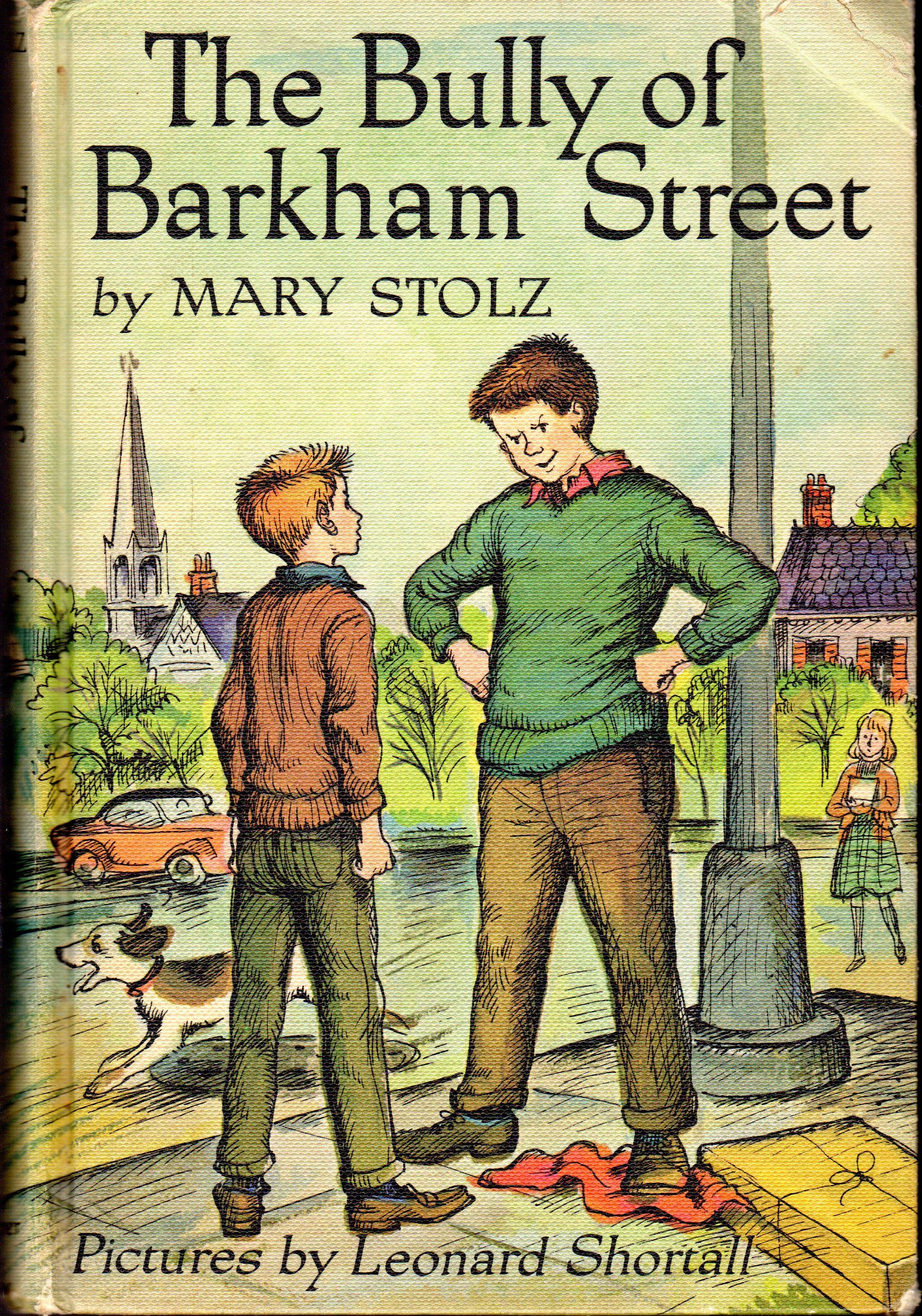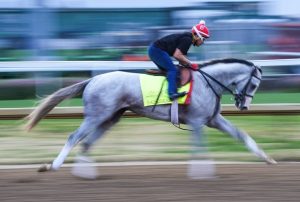The Bully of Barkham Street is a work of juvenilia, written by Mary Stolz and published in 1963. It was a companion piece to A Dog on Barkham Street, which had been published two years earlier. I read them both as a preteen in the 1970s. (There is also, as I just discovered, a third title in the series: 1985’s The Explorer of Barkham Street, which seems akin in its gratuitousness to The Godfather Part III.)
The protagonists of A Dog on Barkham Street are the young Edward Frost, his best friend Rod, and their families. Crucial to the book’s development is the arrival of Edward’s free-spirited Uncle Josh and his dog, Argess.
Edward is plagued by his next-door neighbor, Martin Hastings, the lumbering bully of the block, hated and feared by the neighborhood kids and scorned by the adults. In The Bully of Barkham Street, Martin becomes the protagonist. The narrative is drawn from his viewpoint, with Edward Frost and company the secondary characters.
The Bully of Barkham Street made a colossal impression on me, which on some level I can’t fully explain, nor can I fully explain why the book has stayed with me all these decades later. There were always kids like Martin Hastings about. To say I felt no affinity for them whatsoever is a polite understatement. But Stolz’s narrative rejiggering–Martin as a secondary character in one book, as protagonist in another–fascinated me. I had never come across that before and remember—vividly—that sense of discovery.
There is an element of authorial bravery to plot a book from the perspective of a bully: an unsympathetic, loathsome figure. Stolz walks a fine line, her subtle perch neither downplaying Martin’s bullying nor condoning it, but offering abundant explanation. For one, Bully of Barkham Street reveals that its bully-victim dynamic is slightly more complicated than is portrayed in Dog on Barkham Street. Edward and his friends are not entirely victims, but also instigators, tormenting Martin with cries of fatso and blimpo.
The friendless Martin is in sixth grade, a year older than his classmates and he is—in the unforgiving parlance of the day—fat. His spelling and handwriting are atrocious. Diagnostic understanding, in 1963, was not a thing. Kids like Martin with learning issues were plopped into school and, for the duration, made to feel stupid.
He is also impulsive and undisciplined, lacking the ability to properly care for his beloved dog, Rufus, who—after ample parental warnings—is given away. The presence of the dog Argess—right next door at the Frost household—becomes an endless torment for Martin, a constant reminder that his own ineptitude has cost him his beloved dog.
Bully of Barkham Street also offers an in-depth exploration of the Hastings family. Matin is in constant conflict with his popular, well-adjusted older sister, Marietta. (This equals Martin Marietta, the name of a corporation. One would hope this is sheer coincidence and not some weird product placement.) His father works for an insurance company and is physically and emotionally absent from the household. His mother sells “cosmetics in people’s houses, and it kept her pretty busy afternoons… because the Hastings family needed the extra money she made.” Martin often comes home to an empty house. His family is by no means poor. But there is the steady undercurrent of economic insecurity.
Martin is coarse and hectoring, but he has an active imagination—too active—and he possesses a perceptiveness about the foibles of the adult world. He is antiauthoritarian—misplaced and self-destructive as it may be: “Grown-ups filled him with defiance.” There is an admirable reservoir of cunning, enabling him to wiggle out of potential punishment by confusing the issue at hand: “That was what nearly always happened when grown-ups had ‘little talks’ with him. They started out talking about one thing and ended up in all sort of other directions…”
Bully of Barkham is in–believe it or not–Leave it to Beaver terrain: the same era, the same age cohort, the same vague, but distinctive geographic locus. That show was a much less idealized depiction of family life than is commonly assumed—and also harsher in some of its depictions than people realize. One can’t help reference Larry Mondello, Beaver’s schlubby, good-natured friend. Mr. Mondello is always away and—as is the case with most fathers on Leave it to Beaver—he inspires a good deal of fear. Martin Hastings can be construed as the malevolent Larry Mondello.
I also found Bully of Barkham Street extraordinarily moving—again, for reasons I can’t fully understand. Martin receives the high honor playing reveille on his bugle for the school play. He is uncharacteristically diligent, practicing faithfully and executing a flawless rendition. But on the night of the play, he peers out at the audience from backstage, searching for his mother: “He turned to see his mother, to wave to her and show her how he was one of the good ones this time, and found her yawning widely.
“And after that everything went wrong. He had such a feeling of being let down by evidence of her boredom that all the fun went out of the evening for him.”
Then the unthinkable happens: He steps on stage, puts the bugle to his lips, and produces a “hideous mess,” ruining it completely.
“He looked painfully, through blurred eyes, toward his mother. She wasn’t yawning now. She was sitting up stiff and straight, and when she caught his eye, wriggled her fingers at him and smiled, pretending everything was fine.” But he bravely completes his garbled reveille, returning later to thunderous applause. And, as his mother explains later, she is not bored, but simply tired.
By the book’s end, Martin comes to the point of realization that his methods of functioning are unsustainable: “A step at a time, Martin made his way out of the bully’s desert.” He garners a coveted slot as a paperboy and–with the help of melon and what’s unappetizingly referred to as “dietetic cookies”—makes a conscious effort to slim down. One gets the sense that things will be okay.
When I read Bully of Barkham Street in the early 1970s, the outdated slang puzzled me, but was not a major impediment. The book abounds with creaky vernacular like crums, for the luva mud, in a pig’s eye. Stolz was evidently writing for the 1950s. Yet I didn’t find Bully of Barkham Street all that dated. Eras morphed and shifted, which made for a fascinating, eclectic mélange. The 1950s, to a large extent, were still alive and well. Kojak and The Partridge Family were some of my viewing staples, as was endless news about the Vietnam War. But The Honeymooners, I Love Lucy, and Humphrey Bogart movies were staples as well. Even some physical books from the 1940s made it into my reading life. When I was reading the Barkham books, World War I, silent movies, and the Great Depression were living memories for a good chunk of the population.
I doubt The Bully of Barkham Street would hold any interest whatsoever for today’s young reader. And it might be a stretch to credit it as the forerunner to the more realistic school of YA; a proto-Outsiders. A contemporaneous Kirkus Review lauds the book, but does not find its realism and psychological sophistication startling or even exceptional, which suggests that less rose-colored juvenilia like Bully of Barkham Street was not such an anomaly in 1963. But it still stands out as a work of ingenuity, depth, and emotional power.
The Bully on Barkham Street is, in its own way a bildungsroman, albeit on a small, nondramatic scale. The assumption is that Martin has tamed most of what has bedeviled him and is ready to proceed, more at peace with himself, his family, and the world. It is not the stuff of high drama. But—ultimately–that is the stuff of true profundity








